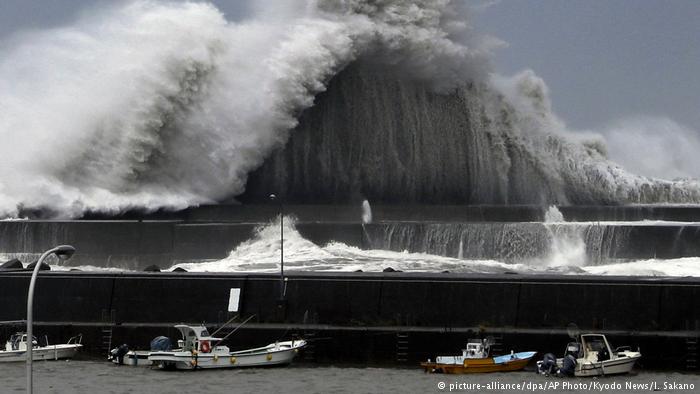Typhoon strikes Japan
September 5, 2018 | Expert Insights

The strongest typhoon to hit Japan in 25 years battered the west of the country on Tuesday (Sep 4) with violent winds and heavy rain, killing seven and injuring scores more.
Flights, trains and ferries were cancelled but thousands of passengers stranded at Osaka's international airport have since been evacuated.
Background
A typhoon is a mature tropical cyclone that develops between 180° and 100°E in the Northern Hemisphere. This region is referred to as the North-western Pacific Basin, and is the most active tropical cyclone basin on Earth, accounting for almost one-third of the world's annual tropical cyclones.
Japan is situated in the “Ring of Fire”, a chain of countries in the Pacific Ocean which have active volcanoes and frequent tropical weather phenomenon like Cyclones. Typhoons are fairly common in Japan at this time of year, although they rarely cause serious damage.
Analysis
Thousands of air passengers in Japan have spent the night stranded in an island airport as Typhoon Jebi created havoc that has led to at least nine deaths, dozens of injuries and evacuation advisories for more than a million people.
Jebi’s arrival followed a summer of extreme weather in the country, including floods and landslides in July in which more than 200 people died, and a record-breaking heatwave that killed dozens of people and sent tens of thousands to hospital.
The typhoon brought widespread disruption to air and rail travel. Almost 800 domestic and international flights were cancelled, along with scores of ferry and train services, the public broadcaster NHK said. Bullet train services between Tokyo and Hiroshima were suspended – but resumed on Wednesday morning – while schools and factories were closed for the day.
An estimated 3,000 people were trapped at the terminal of Kansai international airport, which stands on a manmade island in Osaka Bay, as the typhoon barrelled across large parts of western Japan. Their flights cancelled and with seawater flooding the runway outside, all the passengers could do was sit and wait until they could leave safely. That moment came on Wednesday morning, when high-speed boats began transferring passengers to nearby Kobe airport.
There was no indication when the airport, which operates more than 400 flights a day, would reopen, but it could remain closed for up to a week.
At the other end of a road bridge connecting the airport to the mainland, the Houn Maru, a 2,591-tonne tanker, lurched as waves repeatedly slammed it into the side of the structure. The tanker was damaged, but its 11 crew were unhurt, according to the coast guard.
Television networks showed dramatic live images of waves crashing over sea defences, roof panels being dislodged and blown away by the wind, and high-sided vehicles being lifted on to two wheels and toppling over. Japan is regularly struck by major storms during the summer and autumn. The country has been sweating through a record deadly heatwave that followed devastating rain in parts of central and western Japan that killed over 200 people.
The sustained rain caused widespread flooding and landslides in July, devastating entire villages and forcing thousands from their homes. The flooding and landslides proved so deadly in part because many people did not heed evacuation warnings, which are not mandatory. Since the disaster, authorities have urged people to take the warnings more seriously and prepare to leave home immediately when they are issued.
Assessment
Our assessment is that Japan is experiences strong typhoons every year but Typhoon Jebi has caused large-scale loss of life and property. Therefore, we can except a quick, efficient and focused rebuilding effort from Japan which will mobilise people from across the country. We feel that Japan’s past experience with rebuilding from natural disasters will help it prepare itself better for any unusual weather phenomenon in the near future.








Comments